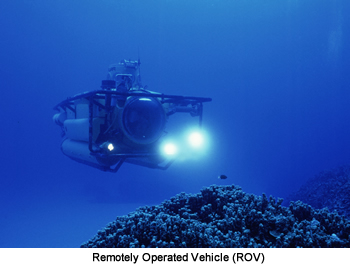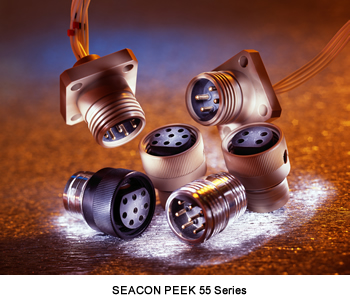Staying Seaworthy with Marine Bulkhead Connectors
Staying Seaworthy with Marine Bulkhead Connectors
SEA CON still sells a significant number of nonmetallic glass-reinforced epoxy connectors, some of which have been in its catalog since its inception nearly 50 years ago. These products serve very well in the underwater industry because they remain corrosion-free and are resistant to other factors that are often associated with metallic connectors.
Rise in Metal Connectors
 A recent trend in the industry is the increase in utilization of metal connectors for marine bulkhead applications. These connectors can be more robust and resist rough handling better than some of the smaller non-metallic products. However, care must be taken to choose the right materials for the job. Type 316 stainless steel has been the industry standard for many years and we still see that material specified by most customers for most applications. But if we go back 25 years or so, we saw significant requirements for aluminum connectors. These were usually 6061 with a hard anodized finish. Aluminum was chosen because it is lightweight, high-strength, offers ease of machining, and has a relatively low cost point. However, it has fallen out of favor because it is very susceptible to corrosion when the anodizing is damaged.
A recent trend in the industry is the increase in utilization of metal connectors for marine bulkhead applications. These connectors can be more robust and resist rough handling better than some of the smaller non-metallic products. However, care must be taken to choose the right materials for the job. Type 316 stainless steel has been the industry standard for many years and we still see that material specified by most customers for most applications. But if we go back 25 years or so, we saw significant requirements for aluminum connectors. These were usually 6061 with a hard anodized finish. Aluminum was chosen because it is lightweight, high-strength, offers ease of machining, and has a relatively low cost point. However, it has fallen out of favor because it is very susceptible to corrosion when the anodizing is damaged.
Since about 1990, there has been a steady growth in the use of titanium in the subsea world. Titanium is also lighter and stronger than 316 stainless steel, but it had the reputation of being expensive in part due to the cost of the metal and in part due to the cost of machining. SEA CON has worked with titanium a great deal over the last quarter of a century, however, and now there is very little extra machining cost compared to 316 stainless.
In addition to these metals, several customers specify other materials, such as Nitronic 50, Super Duplex, or Monel, among others. These materials have strength and corrosion advantages, but there can be a longer lead time to obtain the raw material and they take significantly more time and money to machine.
One of the factors in determining the materials to be used involves the possible level of corrosion. Some materials, such as bare aluminum, are not good choices for many applications, and the combination of materials is also a factor. Galvanic corrosion is related to the use of dissimilar metals and involves the sacrificing of a less noble metal for a more noble one. A bulkhead connector that is quite small compared to the equipment it is mounted on can suffer corrosion if it is a less noble material than the larger equipment to which it is attached. The same can be said of fasteners: A stainless steel screw installed in a titanium plate or in a titanium connector can suffer corrosion in the same way.
Cathodic Delamination
Cathodic delamination is another concern. This phenomenon is related to an electric current in the water and can destroy primers used on metal components before rubber or polyurethane molding. This is most commonly seen in connectors to cable terminations but can be seen in rubber to metal hybrid bulkhead connectors. A long-standing solution to this problem is to use non-metallic connectors such as the SEA CON GRE series or to use non-metallic bulkhead connectors with our rubber molded series of connectors. PEEK has also become more popular as a connector shell material to help with these various corrosion issues. It is non-metallic but it tends to be at least as expensive to buy as titanium in the raw bar form that would be required for machining components.
Pressure
 Another topic in the bulkhead connectors discussion is their ability to handle subsea pressure. Most connectors were designed to be installed on one-atmosphere pressure vessels. However, as the years have gone by, we see more and more usage of pressure-compensated boxes. These compensated systems can save quite a bit of weight and money compared to building pressure vessels. However, this change requires some consideration. Most connectors are designed to keep the ocean out of the connector interface and out of the equipment on which they are mounted, but they may not be designed to hold back several thousand psi of oil from the side that was designed for a dry atmosphere. Some can handle the pressure when mated to a cable connector but may have trouble when mating to a dummy pressure cap. This is because the cap is primarily designed to keep the ocean out but not to keep the electrical insert in place in its housing against significant oil pressure. Dummy connectors can be made to handle such situations but they may cost significantly more than one would anticipate for a dummy.
Another topic in the bulkhead connectors discussion is their ability to handle subsea pressure. Most connectors were designed to be installed on one-atmosphere pressure vessels. However, as the years have gone by, we see more and more usage of pressure-compensated boxes. These compensated systems can save quite a bit of weight and money compared to building pressure vessels. However, this change requires some consideration. Most connectors are designed to keep the ocean out of the connector interface and out of the equipment on which they are mounted, but they may not be designed to hold back several thousand psi of oil from the side that was designed for a dry atmosphere. Some can handle the pressure when mated to a cable connector but may have trouble when mating to a dummy pressure cap. This is because the cap is primarily designed to keep the ocean out but not to keep the electrical insert in place in its housing against significant oil pressure. Dummy connectors can be made to handle such situations but they may cost significantly more than one would anticipate for a dummy.
Compensated systems can also be damaging to bulkhead connectors that are not sealed on what was designed as the dry side. High-pressure oil can sometimes enter a connector from that side but not be able to exit easily enough back through the same path it entered. Instead, it may find an easier way elsewhere, blowing the connector out from the inside and destroying it. This can happen during a deployment but is much more common in a lab pressure test when it is easily possible to drop the pressure from many thousand psi to zero almost instantly. Several thousand psi inside a connector, with one atmosphere outside of it, is not a good thing.
Many companies are changing from metal pressure vessels to plastic compensated boxes. This solves some problems but creates new concerns that must be understood to be avoided. Plastic such as Delrin or PVC has a significantly lower coefficient of friction than most metals. Because of this, it is often desirable to reduce the torque applied to threaded connectors or fasteners in order not to reduce the amount of stress-handling ability left in the part after it is installed. This is especially true of non-metallic connectors, which often do not have as much margin over torque as stainless steel connectors offer. It often is preferable to use a metal connector on a plastic box to minimize the negative effects of the plastic threads in the box.
Testing
A subject that also warrants discussion is when connectors require test ports. Some customers have used test ports built into their equipment for many years. These ports allow for testing to be sure that both O rings seal a dual O ring connector to a piece of equipment before the equipment is deployed. This testing requirement has expanded, so today the connector is manufactured with the test port built into it. Done this way, the vessel it is mounted on can be smaller, which translates into a large cost savings. Additionally, the test port requirement has grown in some industries to include testing of the seals between the two connector halves and sometimes even between the seals within a single connector.[hr]
Ken Northrup, Standard Product Manager, SEA CON
Email SEA CON at [email protected].

